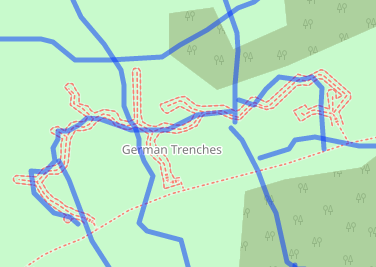The Battle of Vimy Ridge began 100 years ago on April 9th through 12th, 1917. It holds importance in the Canadian consciousness in that this was the first time that the Canadian Corps fought as a single unit on the Western Front with the 1st, 2nd, 3rd and 4th Division deployed side-by-side1. With a lot of patient geo-referencing work and a joint efforts between Muninn, the Canadian Expeditionary Force Study Group and Wikiwar, a number of the units locations, place names and trenches have been extracted. The simplest way at the moment to visualize the locations is through the Open Historical Map which is an OSM-like website that records historical mapping data and can export the raw geometries for further use.
At the time of the Battle of Vimy Ridge, the Headquarters of the Canadian Corps were located near Camblain-l'Abbé (Painted by David B. Milne in 1917). The 1st Canadian Division Headquarters was located in Écoivres near the banks of the La Scarpe river. It's troops were the southernmost deployed with the 17th Corps at their right and the 2nd Canadian Division at their left. The 2nd Canadian Division Headquarters was in a farmer's field near route D58 (There is a google street view pictures of the houses and farms at that current location). The 3rd Canadian Division was next to the left and the 3rd Canadian Division Headquarters was located in Villers-au-Bois. The 4th Division was the northernmost with its flank against the 1st Corps and the 4th Division Headquarters located in a farmer's field near route D65.
How accurate is this information?
 A survey section during the war would be expected to triangulate a feature within 20 yards while out in the field. In actuality areas of high activity were well surveyed and the accuracy of a trench map is often within 5 yards for important features. Since we used hand tracing to extract the trenches some inaccuracy is to be expected. One can do much better by creating a line finding algorithm that traces the trench based on colour separation and that will be the topic of future work. The figure to the right is an overlay of the German trenches extracted from a trench map over the Open Street Map's rendering of the current preserve trenches at the Vimy Ridge Memorial. The alignment is not perfect, but sufficient for way-finding purposes.
A survey section during the war would be expected to triangulate a feature within 20 yards while out in the field. In actuality areas of high activity were well surveyed and the accuracy of a trench map is often within 5 yards for important features. Since we used hand tracing to extract the trenches some inaccuracy is to be expected. One can do much better by creating a line finding algorithm that traces the trench based on colour separation and that will be the topic of future work. The figure to the right is an overlay of the German trenches extracted from a trench map over the Open Street Map's rendering of the current preserve trenches at the Vimy Ridge Memorial. The alignment is not perfect, but sufficient for way-finding purposes.
The location of the Headquarters and the area of operations of the different Divisions, Brigades and Battalions are derived from an aggregate map that was reprojected based on landmarks contained within the current landscape and those within other georeferenced trench maps of the period. The original map was not to scale and large (a 100 meters of so) errors in location can be expected. Of course, features such as a Battalion's area of operations are very large and even a Brigade headquarters involves multiple tents and/or buildings. The map locations on the original source map were simple icons which created their own spatial inaccuracies and one should expect large errors in the actual location. Whenever possible, you should use these features as general areas and not consider their centroid as the ground truth.
This represents the best information currently available and the geometries will improve over time as more information is unearthed. All of these geometries are available from the Open Historical Map's export function which works with all of the tools that were designed for the Open Street Map.
Where did you get this information?
The trenches and trench name information were extracted from maps M_81_000287 and M_89_000382 in the Imperial War Museum's archive. The parameters for the reprojection are described in [1], [2] and this ontology document. Tracing was done manually and exported to both shape files and RDF before being imported to the Open Historical Map.
The location of the headquarters and units during the onset of the battle are derived from the aggregate "map 7" from the Official History of the Canadian Army in the First World War: Canadian Expeditionary Force, 1914-1919 ([3]). The original book was scrubbed for image quality and reprocessed by the good folks at the Canadian Expeditionary Force Study Group before its map was reprojected and bounding areas created before being exported to the Open Historical map.
1. The 5th Canadian Division was not fully formed at the time and it's units were absorbed by the other Divisions.